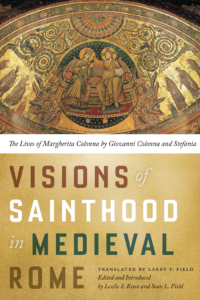As part of our upcoming celebration of the many publications by members of our department in 2016 and 2016 this Friday (4 PM, at Alumni House, 61 Summit Street, Burlington, VT 05401), we are featuring several of the books that will be celebrated.
This featured title is by Professor Sean Field.
 Professor Field’s most recent book is a collaborative translation project, Visions of Sainthood in Medieval Rome: The Lives of Margherita Colonna by Giovanni Colonna and Stefania (University of Notre Dame Press, 2017). Margherita Colonna (c. 1255-1280) was a fascinating holy woman from one of medieval Rome’s most powerful families. Her brother Giovanni was Senator of Rome; her brother Giacomo was a cardinal. Margherita herself is a striking example of a certain kind of medieval sanctity–she was a visionary, dedicated to poverty (in spite of her family’s wealth), working with the poor and sick, but uninterested in becoming a nun. Instead she led an informal group of like-minded women who gathered at the family compound atop Mt. Prenestino (overlooking the town of Palestrina). This project is an English translation of the two contemporary “lives” written about Margherita, as well as a number of associated documents. The lives were written in Latin, and exist in a unique manuscript in the Biblioteca Casanatense in Rome, from which they were edited by a Franciscan scholar in 1935. But even though this kind of text about this kind of medieval holy woman has been the subject of immense interest in recent decades, Margherita’s “lives” have remained almost unknown to scholars. Thus they are an exciting “find” to bring to wider attention, because they are quite unusual in a several ways. The first “life” was written by Margherita’s own brother, the Senator Giovanni Colonna; it is extraordinarily rare to have a Latin life from the thirteenth century written by a layman (not a member of the Church). The second “life” was written by a woman named Stefania, who was one of Margherita’s followers. Although women wrote far more in the Middle Ages than people might assume, this is also a very rare dynamic to find a woman writing a saint’s life (in Latin) about another woman she had known well. Moreover, the texts are just flat out fascinating, filled with visions and family battles and miracles and conflicts of all kinds. For this project, the initial translations from the Latin were done by Larry F. Field (Western New England University), and the texts were then edited and introduced by Lezlie S. Knox (Marquette University) and Sean L. Field (UVM).
Professor Field’s most recent book is a collaborative translation project, Visions of Sainthood in Medieval Rome: The Lives of Margherita Colonna by Giovanni Colonna and Stefania (University of Notre Dame Press, 2017). Margherita Colonna (c. 1255-1280) was a fascinating holy woman from one of medieval Rome’s most powerful families. Her brother Giovanni was Senator of Rome; her brother Giacomo was a cardinal. Margherita herself is a striking example of a certain kind of medieval sanctity–she was a visionary, dedicated to poverty (in spite of her family’s wealth), working with the poor and sick, but uninterested in becoming a nun. Instead she led an informal group of like-minded women who gathered at the family compound atop Mt. Prenestino (overlooking the town of Palestrina). This project is an English translation of the two contemporary “lives” written about Margherita, as well as a number of associated documents. The lives were written in Latin, and exist in a unique manuscript in the Biblioteca Casanatense in Rome, from which they were edited by a Franciscan scholar in 1935. But even though this kind of text about this kind of medieval holy woman has been the subject of immense interest in recent decades, Margherita’s “lives” have remained almost unknown to scholars. Thus they are an exciting “find” to bring to wider attention, because they are quite unusual in a several ways. The first “life” was written by Margherita’s own brother, the Senator Giovanni Colonna; it is extraordinarily rare to have a Latin life from the thirteenth century written by a layman (not a member of the Church). The second “life” was written by a woman named Stefania, who was one of Margherita’s followers. Although women wrote far more in the Middle Ages than people might assume, this is also a very rare dynamic to find a woman writing a saint’s life (in Latin) about another woman she had known well. Moreover, the texts are just flat out fascinating, filled with visions and family battles and miracles and conflicts of all kinds. For this project, the initial translations from the Latin were done by Larry F. Field (Western New England University), and the texts were then edited and introduced by Lezlie S. Knox (Marquette University) and Sean L. Field (UVM).
The editing process for something like this involves going through the unique manuscript word by word to make sure the printed edition is reliable, making any necessary changes, identifying all sources quoted or alluded to by the texts’ authors, and adding critical notes to explain the medieval context to readers. The substantial introduction helps students and other readers to understand the world in which Margherita Colonna and her family lived. It was a really rewarding project to work on, and one that promises to make Margherita Colonna much more widely known to scholars, students, and interested readers. Professor Field learned from this project that if you take on an Italian topic, you get to have some really cool art on your cover.
Please join us on Friday afternoon at Alumni House! Refreshments will be served.
